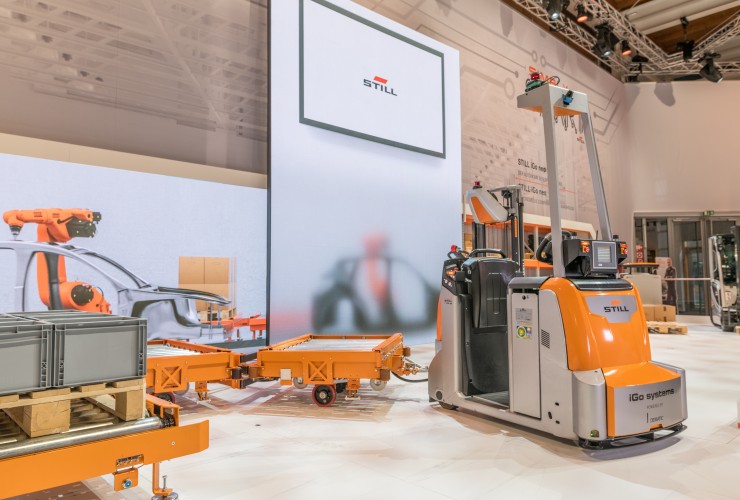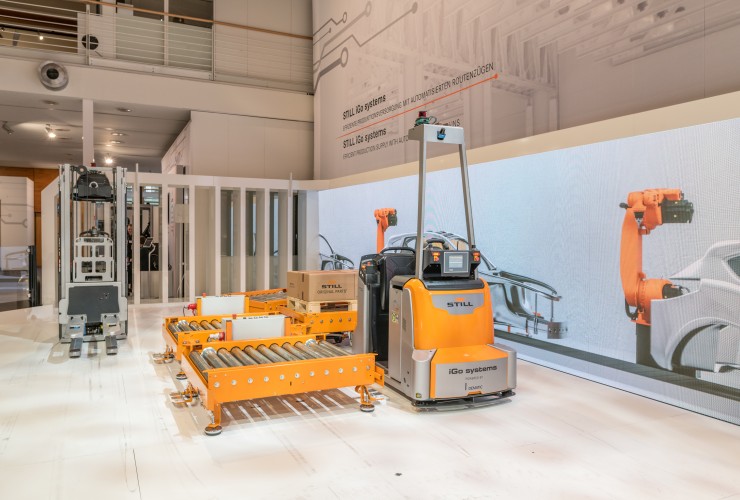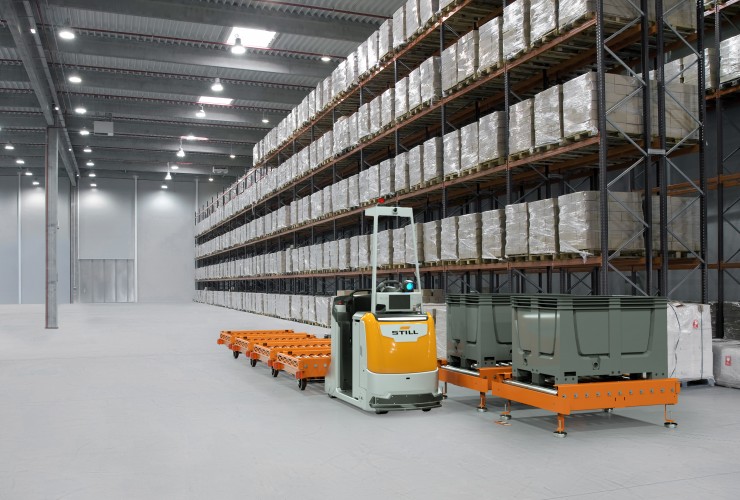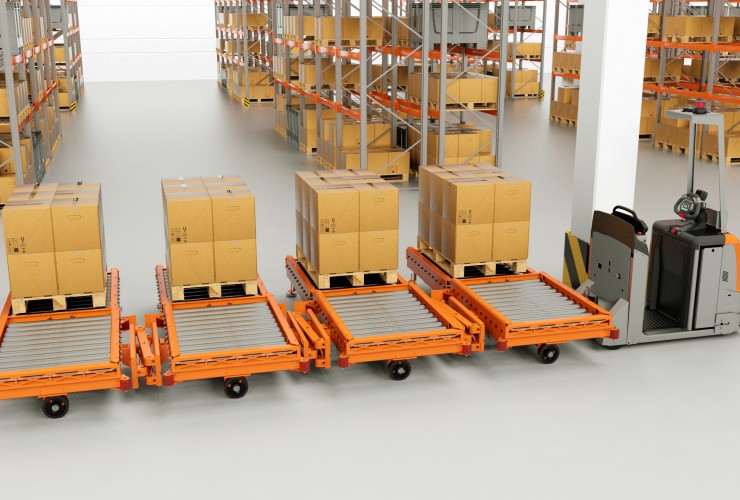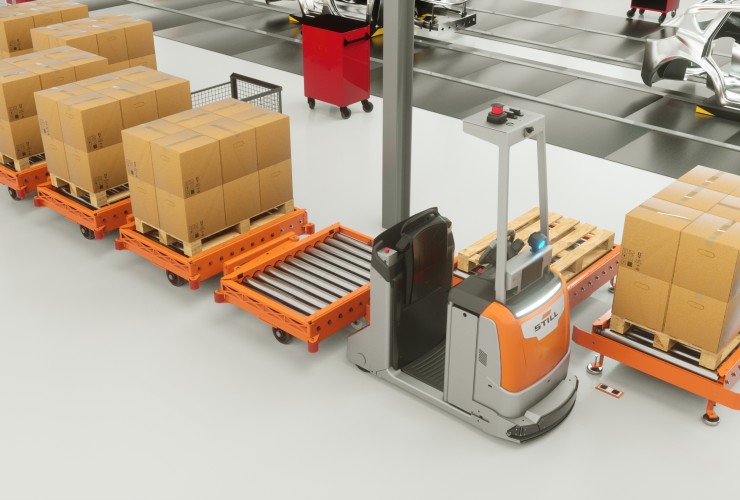IFOY Schirmherrschaft
IFOY Träger
IFOY Partner
Routenzug mit LTX 50 & autom. Be- und Entladung
STILL GmbH
IFOY-Kategorie
AGV & Intralogistic Robot
Zusammenfassung
Mit dem automatisierten Routenzug von STILL wird erstmalig die automatisierte Fahrt mit dem automatisierten Lasthandling in der Produktionsversorgung verbunden. Er zeichnet sich durch hohe Prozesssicherheit, einfache Bedienung sowie durch geringe Implementierungskosten aus.
Beschreibung
Der automatisierte LiftRunner mit LTX 50 ist eine innovative Routenzuglösung, mit dem STILL einen unterbrechungsfreien automatisierten Warenfluss bis ans Produktionsband realisiert und so die taktgesteuerte Belieferung von Produktionslinien noch wirtschaftlicher als bisher gestaltet. Die Lösung kann vor allem für die Ver- und Entsorgung der Produktion im dualen Betrieb, für das automatisierte Lasthandling und für den Streckentransport eingesetzt werden. Als Routenzug zieht der zukunftsweisende Elektroschlepper LTX 50 Anhänger mit einem Gesamtgewicht von bis zu 5.000 Kilogramm spursicher durch Produktionsanlagen. Der Warentransport sowie das Lasthandling erfolgen mit den LiftRunner-Rahmen, auf dem sich eine Fördertechnik in Form von zwei elektrisch angetriebener Rollenbahnen befindet. Für die Lastübergabe wird der automatisierte Rahmen vor eine kompatible Übergabestation gefahren. Zwei Sensoren sorgen dafür, dass sich der LiftRunner-Rahmen durch Absenken und Positionieren mit der Übergabestation verbindet. Die Übergabestationen erhalten Energie und Information vom Rahmen und müssen daher nicht in die IT Struktur des Unternehmens eingebunden werden. Dank Lasernavigation kann bis auf einen Zentrimeter Genauigkeit positioniert werden. Der Be- oder Entladevorgang startet durch die Freigabe der Fördertechnik. Ein weiterer Sensor beendet den Fördervorgang und stellt dabei sicher, dass eine vollständige Be- beziehungsweise Entladung erfolgt ist.
Bewerbungsdaten
Innovation
Die wichtigste Innovation des automatisierten LiftRunners mit LTX 50 besteht in der Kombination des automatisierten Fahrens und des automatisierten Lasthandlings für unterschiedliche Behältergrößen. Bisher war entweder nur das automatisierte Fahren oder das automatisierte Lasthandling möglich, jedoch keine Kombination aus beidem. Die neue Lösung ermöglicht zum einen die automatisierte Fahrt zu unterschiedlichen Haltepunkten, zum anderen die automatisierte Entladung der Rahmen, die systemseitig initiiert wird. STILL eröffnet seinen Kunden mit dem automatisierten LiftRunner und den Übergabestationen noch weitere neue Möglichkeiten. Beim manuellen Routenzugeinsatz war das Lastgewicht auf circa 500 Kilogramm je Anhänger limitiert, da die Last mithilfe von Muskelkraft vom Trolley herunter- beziehungsweise herausgeschoben werden musste. Jetzt können jedoch auch Lasten von bis zu 1.200 Kilogramm pro Rahmen zur Produktion gebracht werden.
Marktrelevanz
Der Routenzug lässt sich zum jetzigen Zeitpunkt nicht durch andere Transportlösungen ersetzen. Er stellt die einzige Lösung dar, die gebündelte Transporte abbilden kann. Zudem gibt es auf dem Markt keine vergleichbaren automatisierten Routenzüge, die sowohl eine automatisierte Fahrt als auch ein automatisiertes Lasthandling ermöglichen. Deshalb setzt der vollautomatisierte Routenzug von STILL neue Maßstäbe, da diese Kombination mit der von STILL entwickelten Lösung realisiert werden kann. Die Marktnachfrage nach automatisierten Transportlösungen ist sehr hoch und schnell wachsend. Der Markt für diese Fahrzeuge wird voraussichtlich bis 2025 um rund 30 Prozent wachsen. Vor allem die Automobilindustrie zeigt großes Interesse an dieser Lösung. Die Zielgruppe sind Unternehmen, die zum einen Routenzüge einsetzen, die überwiegend schwere Lasten bewegen müssen, oder Firmen, die ihre Mitarbeiter bei der Arbeit entlasten möchten.
Hauptvorteile für den Kunden
Der automatisierte LiftRunner mit LTX 50 ermöglicht den Kunden eine effiziente und schlanke Produktionsversorgung. Gleichzeitig hilft er den Kunden das innerbetriebliches Verkehrsaufkommen zu reduzieren. Durch diese Lösung wird der vollautomatisierte Materialfluss vom Lager bis zum Verbauort in Verbindung mit gebündeltem Transport möglich. Zudem können auch schwere Lasten in die Routenzugversorgung der Produktion eingebunden werden. Die hohe Prozessstabilität und -sicherheit sorgen zusätzlich für hohe Qualität und Fehlerfreiheit.
Technische Daten
Video: Automated interaction with high lift pallet truck, electric tractor and E-Frame
IFOY Test
| Truck Name | STILL |
| Truck Type | Automated tugger train with LTX 50 |
| Date of Test | 08.03.2019 |
Testbericht
Intralogistische Prozesse werden zunehmend vollständig oder teilweise automatisiert. Mit der Kombination aus LiftRunner und LTX 50 Traktor präsentiert Still eine Lösung, die erstmals sowohl den Transport als auch das Lasthandling vollautomatisch übernimmt.
Der serienmäßige Elektroschlepper LTX 50 mit einer maximalen Zugkraft von 5.000 kg ist mit Automatisierungskomponenten der KION-Schwester Dematic ausgestattet. Auffälligstes Merkmal ist der an der Vorderseite des Staplers angebrachte Automatisierungsbogen, der alle notwendigen Komponenten wie Lasernavigation, WLAN, speicherprogrammierbare Steuerungen und zwei Sick-Scanner integriert. Die KION Option Box, kurz KOB genannt, ist unter der Haube montiert. Die KOB ermöglicht eine einfache Kommunikation mit der Steuerungseinheit des Fahrzeugs.
Ein großer Vorteil dieser Kombination ist, dass die Prozesse - wenn gewünscht - auch manuell durchgeführt werden können. Neben der für den IFOY AWARD nominierten vollautomatischen Lösung ist eine Variante erhältlich, bei der nur der Transport automatisiert wird und das Handling manuell erfolgt. Bei einer weiteren Variante wird das Lasthandling automatisch übernommen und der Transport erfolgt manuell.
Die automatisierten Ablade- und Abholplätze benötigen keine eigenen Stromversorgungen. Die Rollenbahn an diesen Haltestellen wird von den Anhängern des Zuges angetrieben, die dazu mit 24 Volt-Kontakten ausgestattet sind. Sobald sich der Anhänger an der richtigen Position befindet und absenkt, wird der Kontakt hergestellt und die Rollenbahn beginnt sich zu drehen. Datenfotozellen ermöglichen die Kommunikation zwischen den Anhängern und den stationären Rollenbahnen. Dadurch wird die Flexibilität der Lösung deutlich erhöht. Das System zeichnet sich auch durch seine Einfachheit und die relativ geringe Investition aus.
Da das Lasthandling jetzt auch automatisiert ist, können schwerere Lasten als bisher bewegt werden. War das Gewicht der Ladung bisher auf ca. 500 kg begrenzt, können nun Lasten mit einem Gewicht von 1.200 kg pro Anhänger problemlos transportiert werden.
Die Sicherheit wird durch die SPS-Steuerung und die Sick-Sensoren im Automatisierungsbogen gewährleistet. Darüber zeigen LED-Leuchten im Lichtbogen an, wenn Aktivitäten durch die Kombination ausgeführt werden. Zudem ist der Truck mit einem BlueSpot ausgestattet, der nur funktioniert, wenn tatsächlich gefahren wird. Die Bündelung der Transporte reduziert die Intensität des internen Transports, was eindeutig der Sicherheit zugute kommt.
Während der IFOY Testwoche zeigte der Still LTX mit LiftRunner einen reibungslosen Transport im rekonstruierten praktischen Aufbau. Es gibt zwei Aufnahme-/Ablieferpositionen ohne externen Stromanschluss und der Traktor ist mit zwei Anhängern ausgestattet. In der Praxis hat sich gezeigt, dass der theoretische Betrieb reibungslos verläuft. Das Heben und Fördern von Lasten durch unbemannten Transport ist reibungslos und kontrolliert.
IFOY Testfazit:
Still LiftRunner mit LTX ermöglicht es, sowohl den Transport als auch das Lasthandling vollautomatisch durchzuführen. Das System ist skalierbar, leicht anpassbar und kann teilweise manuell betrieben werden. Die Lösung ist ideal für z.B. die Ver- und Entsorgung von Produktionslinien oder andere sich wiederholende Tätigkeiten. Durch die vollständige Automatisierung dieser Prozesse erhöhen sich Zuverlässigkeit und Sicherheit, während Transport und Handling wirtschaftlicher erfolgen.
IFOY Innovation Check
IFOY Innovation Check
Marktrelevanz
Routenzugsysteme setzen sich seit einigen Jahren, ausgehend aus der Automobilindustrie, in immer mehr Branchen durch. Studien zeigen, dass ein höherer Automatisierungsgrad gewünscht ist, aber derzeit eine überwiegende Mehrheit der Systeme weitgehend manuell betrieben wird. Eine Automatisierung ergibt erst dann Sinn, wenn diese durchgehend ist. Das vorgestellte System realisiert dies und öffnet damit den Weg zur nächsten Generation vollständig automatisierter Routenzugsysteme.
Kundennutzen
Automatisierte Systeme mit manuellem Lastwechsel eröffnen nicht das ganze Kosteneinsparungspotenzial von Routenzugsystemen. Die durchgängige Automatisierung erlaubt hier zumindest für Paletten und Großladungsträger einen kompletten Verzicht auf menschliche Eingriffe während der Materialversorgung. Die Einfachheit der dezentralen Lastübergaben erlaubt diese flexibel einzusetzen und auch zu verändern
Neuheitsgrad
Automatisch verfahrende Schlepper sind als Technologiezwilling von Fahrerlosen Transportsystemen (FTS) bekannt, wenn auch noch nicht sehr weit verbreitet. Bisher lohnt sich der Einsatz nur bei großen Entfernungen vom Materiallager zur Produktion. Der Systemgedanke von automatisierter Lastübergabe und automatisiertem Fahren ist in dieser Kombination eine Innovation, die auf evolutionäre Weise einen zusätzlichen Nutzen in der Produktionsversorgung stiftet und dennoch den verkehrsreduzierenden Gedanken von Sammeltransporten weiterhin erlaubt.
Funktionalität / Art der Umsetzung
Das System ist intelligent aufgebaut, vor allem durch die vergleichsweise komplexen, aber betriebssicheren Anhänger und die sehr einfach aufgebauten und komplett auf eigene Versorgung verzichtenden dezentralen Lastübergabestellen.
|
Marktrelevanz |
++ |
|
Kundennutzen |
+ |
|
Neuheits- / Innovationsgrad |
+ |
|
Funktionalität / Art der Umsetzung |
++ |
|
++ sehr gut / + gut / Ø ausgeglichen / - weniger / - - nicht vorhanden |
|
Automated tugger train with LTX 50 & automated load handling
STILL GmbH
IFOY category
AGV & Intralogistics Robot
Summary
The STILL automated tugger train combines for the first time automated driving with automated load handling in production supply. The tugger train’s characteristic features in this respect are great process safety, easy handling and low implementation costs.
Description
The automated LiftRunner with LTX 50 is an innovative tugger train solution. The solution insures an uninterrupted, automated flow of goods right up to the production line, thus providing a economical cycle-controlled production line supply system. The main uses of the solution are for supply and offtake to and from production processes, in dual operation, for automated load handling and for distance transport. When used as a tugger train, the pioneering LTX 50 battery-operated truck pulls trailers with a total weight up to 5,000 kilograms sure-footedly through production plants. LiftRunner frames take care of the goods transport and load handling. LiftRunner frames carry conveyor technology in the form of two electrically-driven roller tracks. To transfer loads, the automated frames are driven up to a compatible handover station. Two sensors ensure that the LiftRunner frame connects to the transfer station by lowering and positioning. Transfer stations obtain energy and information from the intelligent frame, they do not need to be integrated into the company’s IT structure. Laser navigation enables positioning accurate to one centimeter. The loading or unloading process is started by enabling the conveyor technology. Another sensor completes the conveying process, ensuring at the same time that complete loading or unloading has taken place.
Entry Data
Innovation
The most important innovation of the automated LiftRunner with LTX 50 lies in its combination of automated driving and automated load handling for different container sizes. Either automated driving or automated load handling was possible in the past, but not a combination of both. Therefore the solution developed by STILL enables firstly automated driving to different stopping points, and secondly automated, system-initiated frame unloading. Through the automated LiftRunner and transfer stations, STILL opens up to its customers even more new opportunities. When using tugger trains by hand, the load weight was limited to about 500 kilogram per trailer, because the load needed to be pushed manually down from or out of the trolley. Now, however, loads up to 1,200 kilogram per frame can also be brought to the production process.
Marktet relevance
At the moment a tugger train cannot be replaced by other transport solutions, since it is the only solution that can offer combined transport processes. Moreover, there are no comparable tugger trains on the market that enable both automated driving and automated load handling. Therefore the STILL fully-automated tugger train sets new standards, since this is precisely the combination that is achievable by using the solution developed by STILL. The market demand for automated transport solutions is large and fast-growing. The market for these trucks is expected to grow by approximately 30 percent by 2025. The automobile industry in particular shows great interest in this solution and has a large demand. The target group are companies that use a tugger train mainly to move heavy loads or want to reduce the workload on their employees.
Main customer benefits
The automated LiftRunner with LTX 50 enables customers to achieve slim, efficient production supply systems, while reducing their intralogistics traffic volume at the same time. This solution allows fully-automated material flow from the warehouse to the assembly point, in combination with bundled transport. Heavy loads can also be integrated into the tugger train system of the production unit. In addition, the high level of process stability, safety and security ensure high quality and no errors.
Technical data
Video: Automated interaction with high lift pallet truck, electric tractor and E-Frame
IFOY Test
| Truck Name | STILL |
| Truck Type | Automated tugger train with LTX 50 |
| Date of Test | March 8, 2019 |
Test Report
More and more intralogistic processes are fully or partially automated. With the combination of the LiftRunner and the LTX 50 tractor, Still presents a solution that for the first time takes care of both transport and load handling fully automatically.
The standard LTX 50 electric tow tractor, with a maximum pulling force of 5,000 kg, is equipped with automation components from KION sister Dematic. The most striking feature is the automation arch mounted on the front of the truck, which integrates all the necessary components such as laser navigation, WLAN, safety PLCs and two Sick scanners. The KION Option Box, or KOB for short, is mounted under the hood. This KOB enables easy communication with the controls of the vehicle.
A major advantage of this combination is that the processes can - if desired - also be carried out manually. In addition to the fully automated solution nominated for the IFOY AWARD, a variant can be chosen in which only the transport is automated and the handling takes place manually, but also a version in which the load handling is automatically taken care of and the transport takes place manually.
The automated drop-off and pick-up locations do not require their own power supplies. The roller conveyor on these stops is driven by the trailers of the goods train, which are equipped with 24 Volt contacts for this purpose. As soon as the trailer is at the right location and lowers, contact is made and the roller conveyor starts to run. Data photocells provide communication between the trailers and the stationary roller conveyors. This significantly increases the flexibility of the solution. The system is also characterised by its relative simplicity and relatively low investment.
Because load handling is now also automated, heavier loads can be handled than before. Where the weight of the load was previously limited to approximately 500 kg, loads weighing 1,200 kg per trailer can now be easily transported.
Safety is guaranteed by the safety PLCs and the Sick sensors in the automation arch. In addition, LED lights in the arc make it clearly visible to the environment when activities are carried out by the combination. Furthermore, the truck is equipped with a BlueSpot that only works when there is actually driving. Moreover, the bundling of the transports reduces the intensity of the internal transport. And that obviously benefits safety.
During the IFOY Testweek, the Still LTX with LiftRunner provides trouble-free transport in the reconstructed practical set-up. There are two recording/delivering positions without external power connection and the tractor is equipped with two trailers. In practice, the theoretical operation appears to run smoothly. The lifting and delivery of loads through unmanned transport is smooth and controlled.
IFOY test verdict:
Still LiftRunner with LTX makes it possible to handle both transport and load handling fully automatically. The system is scalable, easily adaptable and can be partly manual. The solution is ideal for, for example, the supply and removal of products to and from production lines, or other repetitive work. By fully automating these processes, reliability and safety increase, while transport and handling are carried out more economically.
IFOY Innovation Check
IFOY Innovation Check
Market Relevance
Tugger train systems have been established in more and more industries for some years now, starting with the automotive industry. Studies show that a higher degree of automation is desirable, but that the vast majority of systems are currently operated largely manually. Automation only makes sense, if it is continuous. The presented system makes that happen and opens the way to the next generation of completely automated tugger train systems.
Customer Benefit
Automated systems with manual load changes do not open up the full cost saving potential of tugger train systems. The integrated automation allows a complete renunciation of human intervention during material supply, at least for pallets and large load carriers. The simplicity of decentralized load transfer allows these to be used flexibly and also to be changed.
Degree of Novelty
Automatically driven tugger are known as technology twins of Automated Guided Vehicles (AGVs), although they are not yet very widespread. So far, it has only been worthwhile to use them for long distances from material storage to production. In this combination, the system concept of automated load transfer and automated driving is an innovation that provides an evolutionary additional benefit in the production supply and still allows the traffic-reducing idea of collective transports.
Functionality / Type of Implementation
The system has an intelligent design, above all due to the comparatively complex but reliable trailers and the very simple design of the decentralised load transfer points, which completely dispense with their own power supply.
|
Market relevance |
++ |
|
Customer benefit |
+ |
|
Degree of novelty / innovation |
+ |
|
Functionality / Type of implementation |
++ |
|
++ very good / + good / Ø balanced / - less / - - not available |
|












